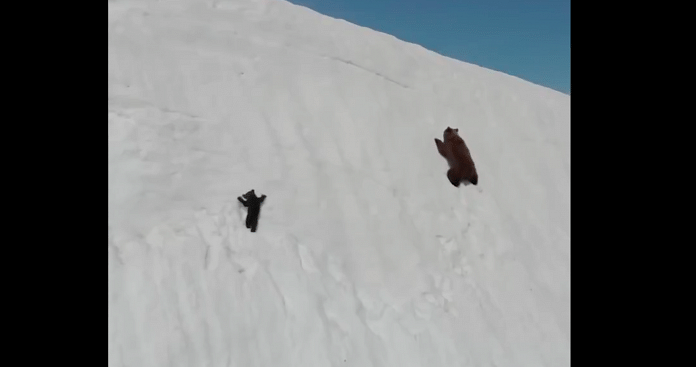ScientiFix, our weekly feature, will offer you a summary of the top global science stories of the week, with links to the best sources to read them. It’s your fix to stay on top of the latest in science.
Video of a cub struggling to climb a steep icy slope stokes a row
Last weekend, a viral video posted on Twitter showed a mama bear and a cub emerge on icy slopes, with the little one struggling to keep up with the mother. As it attempted to climb to the top, it slipped and fell multiple times, until it finally reached the mother bear. As the video was shared widely for exemplifying persistence, biologists and drone operators took to Twitter to point out that the bears were put in the very precarious position they were trying to get out of by the same drone camera that captured the whole thing. Read our own story here.
Mysterious bubbling pool of mud is travelling through California
In a tectonically active region off California, researchers have discovered that a bubbling mud spring that first appeared in 2016 on the ground is moving at the rate of 20 ft per year. It has moved in a straight line and has remained a circular structure, without stretching out straight. This region sees massive deposition of sediments from the Colorado river and the subsequent heating up of the lower sediment layers because of the pressure above it. The heated layers undergo metamorphosis and transform to new rock, releaseing carbon dioxide, forming mud pots. The pot is currently moving towards railway tracks, and efforts by engineers to artificially pump out the gas has seen the pot mysteriously “duck” under the pumps and continue on its path. National Geographic has more details.
Elephants will soon be born without tusks if poaching continues
A new research has shown that our giant pachyderm friends have kicked in the ultimate defence to protect themselves against harmful human practices: evolution. Elephants in Africa have dwindled down by 90 per cent due to poaching for tusks. Once males are hunted enough for tusks to become rare, poachers go after older females. Larger tusks are more valuable, and survivors of decades of poaching tend to be individuals with smaller or no tusks. This has now propagated in their gene pool. Usually, 2 to 4 per cent of females are born without tusks, but in recent years, the number has risen to 33 per cent. This spells bad news for the ecosystem as tusks help elephants with major daily tasks like digging for water, and several other animals depend on the elephant’s role in the ecosystem. National Geographic has the story.
A rare Mandarin duck reappears in New York City
On 10 October, a colourful Mandarin duck suddenly appeared in a pond in Central Park, New York City. No one knew where the duck came from, as the species is native to Asia and is found primarily in the countries of China and Japan. The duck attracted thousands of tourists, but soon disappeared. It has now been spotted again in the Hudson River, the mystery of its origins still looming large. The Guardian’s report.
DNA of the world’s oldest natural mummy revealed
Researchers have revealed the DNA sequencing of the world’s oldest natural mummy, a skeleton over 10,000 years old. The mummy was a 40-year-old male when he died in a blanket in the arid Nevada region, where he was preserved. A large study that was tracing human migration through North and South America during the Ice Age was responsible for dating him, and the DNA sequencing revealed that he is related to a Native American tribe currently in the Nevada region. History.com has more on it.
California ravaged by deadliest fire in history
The fire-prone state of California is currently reeling under three big blazes, one of which is the most destructive the state has ever seen. Camp Fire, Hill Fire, and Woolsey Fire have together destroyed more than 75,000 acres of land, towns, film sets, buildings, and more. More than 50,000 people have evacuated their towns, even as surreal videos of fire phenomena and destruction make their way to social media under the hashtag #CaliforniaFires. Wired explains the science behind why these fires.






